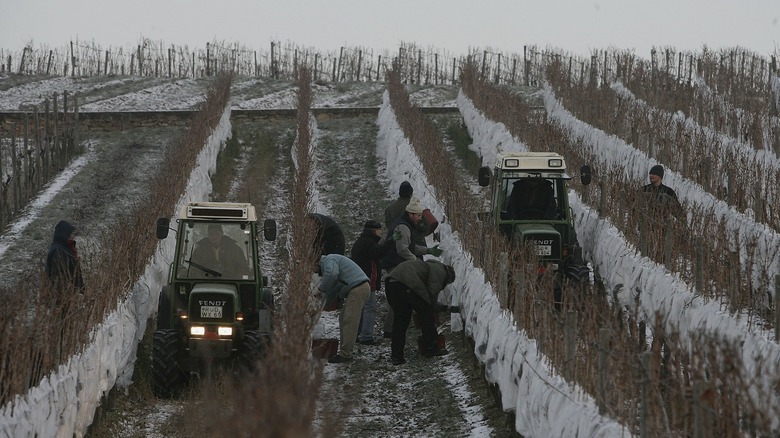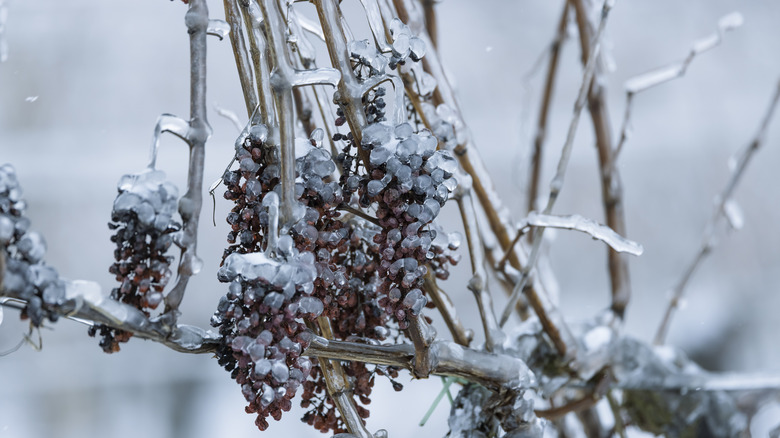Here's What To Keep In Mind When Serving Ice Wine
For some, the term ice wine might bring to mind a glass of vino on the rocks, which is exactly how Diane Keaton prefers to drink her eponymous red blend. But in reality, ice wine has nothing to do with swirling ice cubes, instead, it's a distinct style of sweet dessert wine. The painstaking method for making ice wine involves frozen grapes and nighttime harvests. As such, it shouldn't come as a surprise that ice wine's biggest producers are based in cold climates like Michigan, upstate New York, parts of Canada, Austria, and Germany.
For all its singularity in taste and production — more on that later — one of the unique things about ice wine is the way it's served. Rather than fetching it from a cellar and pouring it straight into a standard vessel, the best way to imbibe the wintry libation is to chill it to between 46 to 50 degrees Fahrenheit. To avoid serving it too cold, one of the biggest mistakes people make when chilling wine, let it sit for just a couple of hours in the fridge or for a shorter amount of time in the freezer. Sommeliers will tell you to serve it in a frosty tulip-shaped glass, which brings out its fragrant notes.
The colder, the sweeter
The serving temperature of ice wine is only part of what makes it stand out. Its flavor, though widely varied, is categorically sweet and unlike any other dessert wine. That's thanks to its grapes, which are picked at a later stage than those for standard wines. Harvesters don their headlamps and gather the frozen, over-ripe grapes — including white varietals like Vidal Blanc and Riesling and reds like Cabernet Franc — at night when the air is coldest. The sugar in the grapes is concentrated into the ice crystals, yielding an exceptionally sweet drink with a touch of acidity to balance things out.
While ice wine has only been in mass production since the 20th century, historians believe the practice of making wine from frozen grapes has been around for much, much longer. For instance, a monument in the German city of Bingen bills the first recorded harvest of ice wine (or eiswein, as it's called in Germany) to 1830. Off book, some believe that German farmers began making the chilled tipple nearly a century earlier to salvage grapes hit by unexpected frost.
Dessert and beyond
Many will find ice wine simply too sweet to pair with a main course. And while it could stand alone as a dessert itself, it doesn't necessarily need to be enjoyed on its own. It plays well with plenty of flavors, both sweet and savory, for dessert and small bites.
The fruity notes of Vidals and Rieslings are delicious alongside fresh fruit, fruit-based desserts, and rich custards, while red ice wines bring out the decadence in chocolate. Meanwhile, cheese lovers will be glad to know that ice wine and fromage rarely butt heads. Pungent cheeses both hard and soft will do, from Roquefort and other types of blue cheese to Parmigiano Reggiano. Veering further into the savory camp, some say ice wines make great bedfellows with spicy and salty foods.
Whatever comestibles you choose to serve alongside your ice wine, make your decisions wisely. Due to the drink's specialized production process and the limited amount of liquid pressed from the frozen grapes, it tends to cost more than your average bottle.


